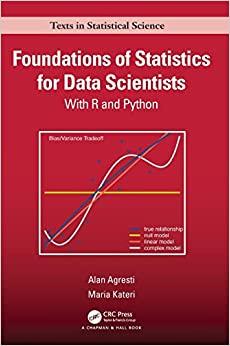Inconductingalargenumberofsignificancetests,the false discoveryrate (FDR) isthe expectedproportionoftherejectednullhypothesesthatareerroneouslyrejected.Asimple algorithm canensureFDR when appliedwith t independenttestsandisespeciallyuseful when asmallproportionofthenullhypothesesareexpectedtobefalse.Let P(1)
Question:
Inconductingalargenumberofsignificancetests,the false discoveryrate (FDR) isthe expectedproportionoftherejectednullhypothesesthatareerroneouslyrejected.Asimple algorithm canensureFDR ≤ α when appliedwith t independenttestsandisespeciallyuseful when asmallproportionofthenullhypothesesareexpectedtobefalse.Let P(1) ≤ P(2) ≤ ⋯ ≤
P(t) denote theordered P-values.Themethodrejectshypotheses(1),…,(j∗), where j∗ is the maximum j for which P(j) ≤ jα~t.
(a) ExplainwhytheFDRandBonferronimakethesamedecisionforthemostsignificant test, butotherwisetheFDRmethodrejectsinatleastasmanycasesastheBonferroni method.
(b) Thestatisticians(YoavBenjaminiandYosefHochberg)whointroducedthismethodin 1995 illustratedtheFDRforastudyaboutmyocardialinfarction.Forthe15hypotheses tested inthestudy,theordered P-values(P(1),P(2), ...,P(15)) were 0.0001, 0.0004,0.0019,0.0095,0.020,0.028,0.030, 0.034, 0.046,0.32,0.43,0.57,0.65,0.76,1.00.
With α = 0.05, indicatewhichhypothesesarerejectedwiththeFDRmethodandwith the Bonferronimethod.
Step by Step Answer:

Foundations Of Statistics For Data Scientists With R And Python
ISBN: 9780367748456
1st Edition
Authors: Alan Agresti






